Abstract
The probability of recovering pathogenic Escherichia coli from food by the Bacteriological Analytical Manual method was determined by the effects of several factors: the number of strains per food, the ability of pathogenic strains to survive enrichment, and the frequency of plasmid loss during enrichment. Biochemical patterns indicated the presence of about six E. coli strains per food sample. About half of the strains isolated from humans did not survive enrichment. Among those which grew, plasmid loss, as determined by gel electrophoresis and DNA colony hybridization, ranged from 20 to 95%. The combined effects of failure to survive enrichment and plasmid loss decreased the relative numbers of these strains and reduced the chance of detecting pathogens. To counteract this tendency and obtain a 90 to 95% probability off recovering a given pathogenic strain, 40 to 50 colonies per food sample should be picked during the routine testing of foods.
Full text
PDF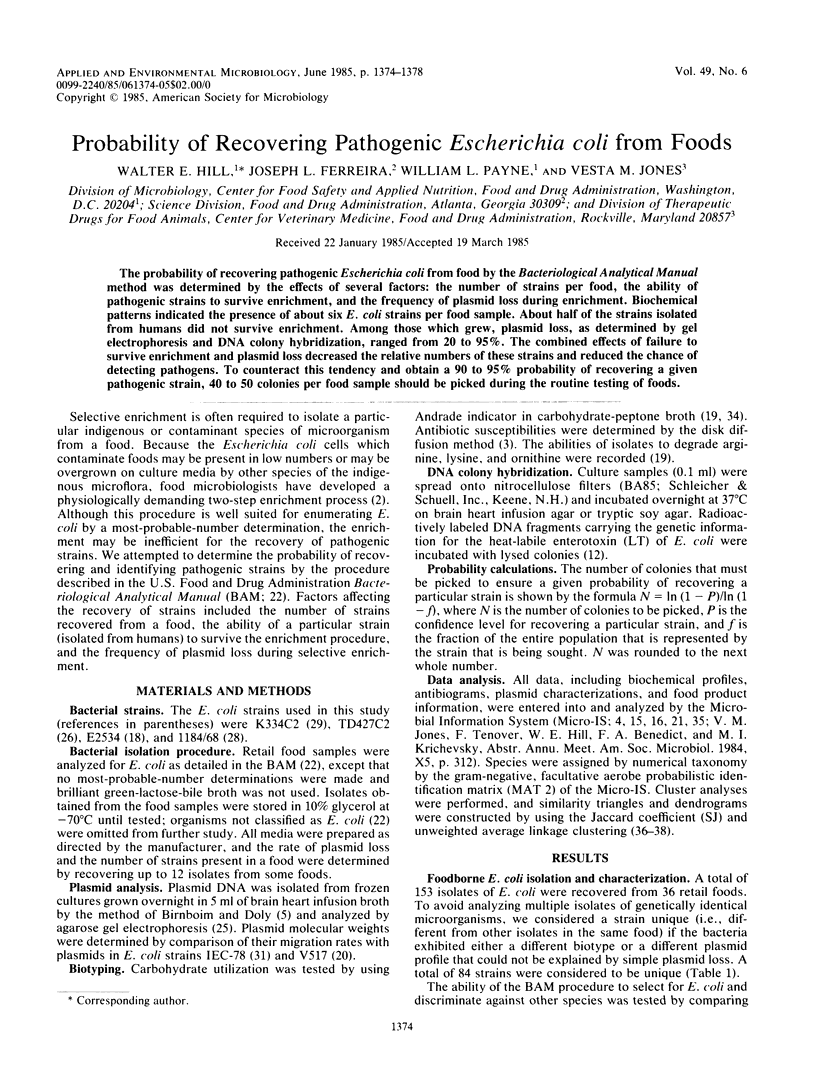
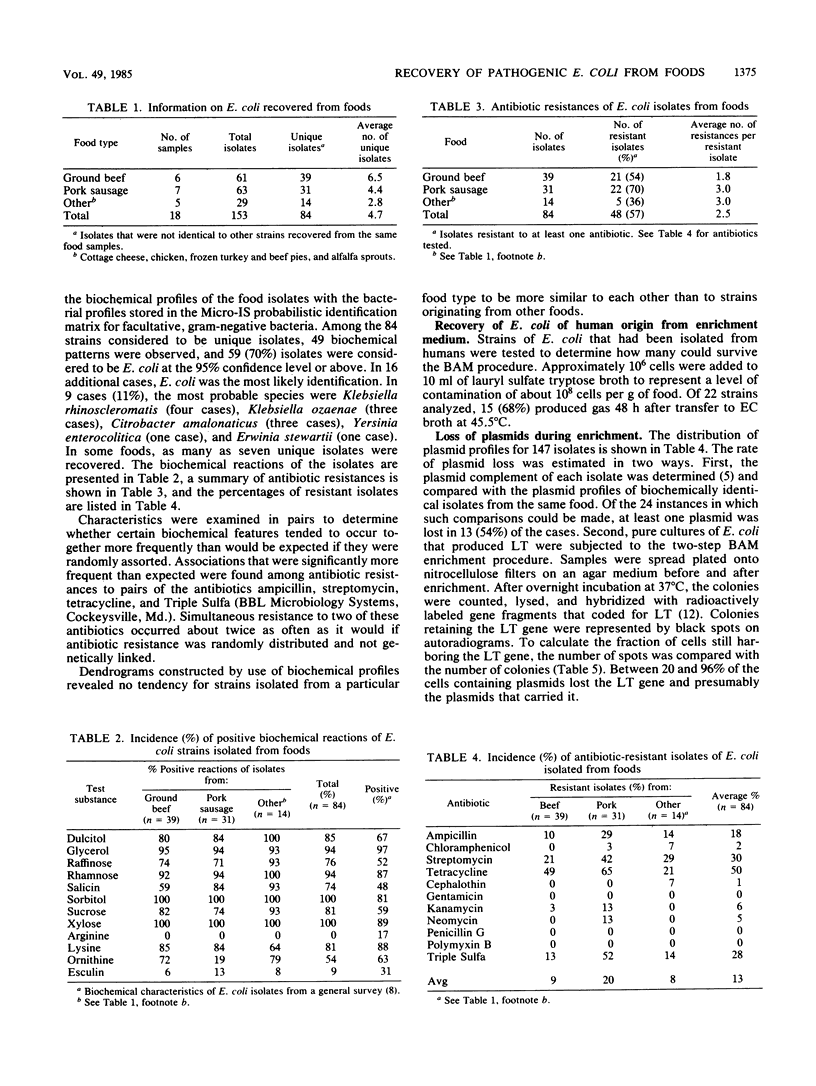
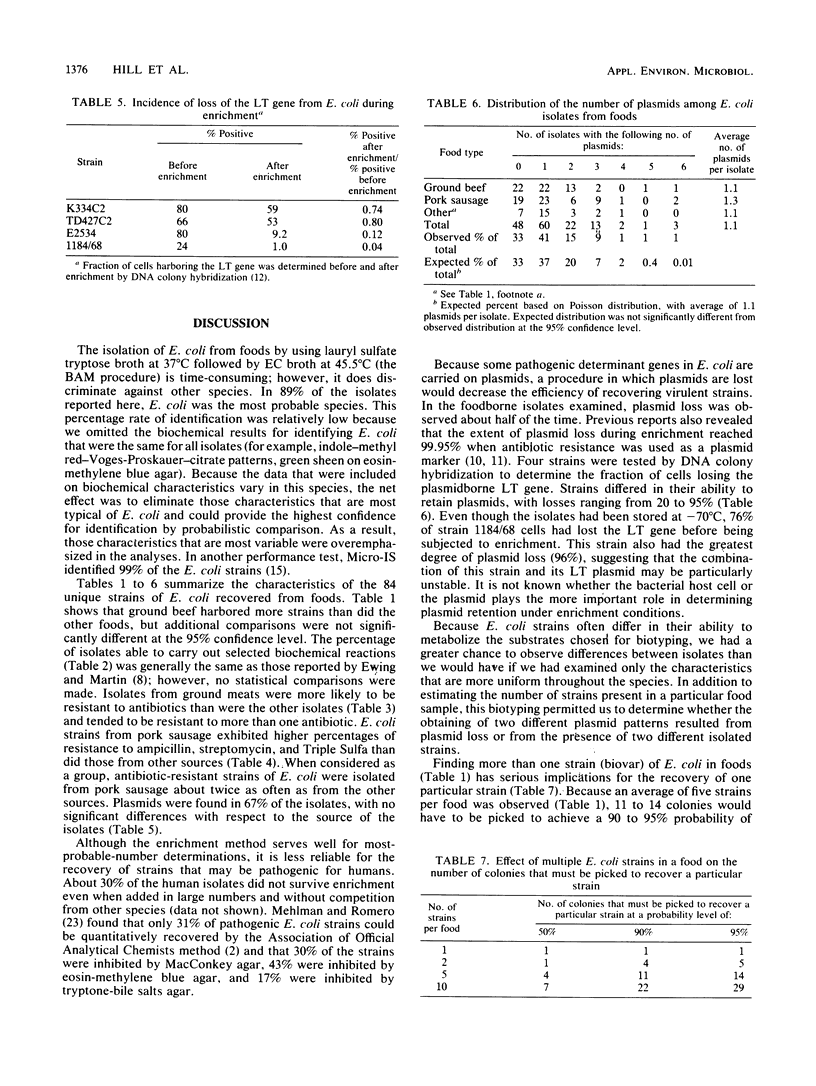
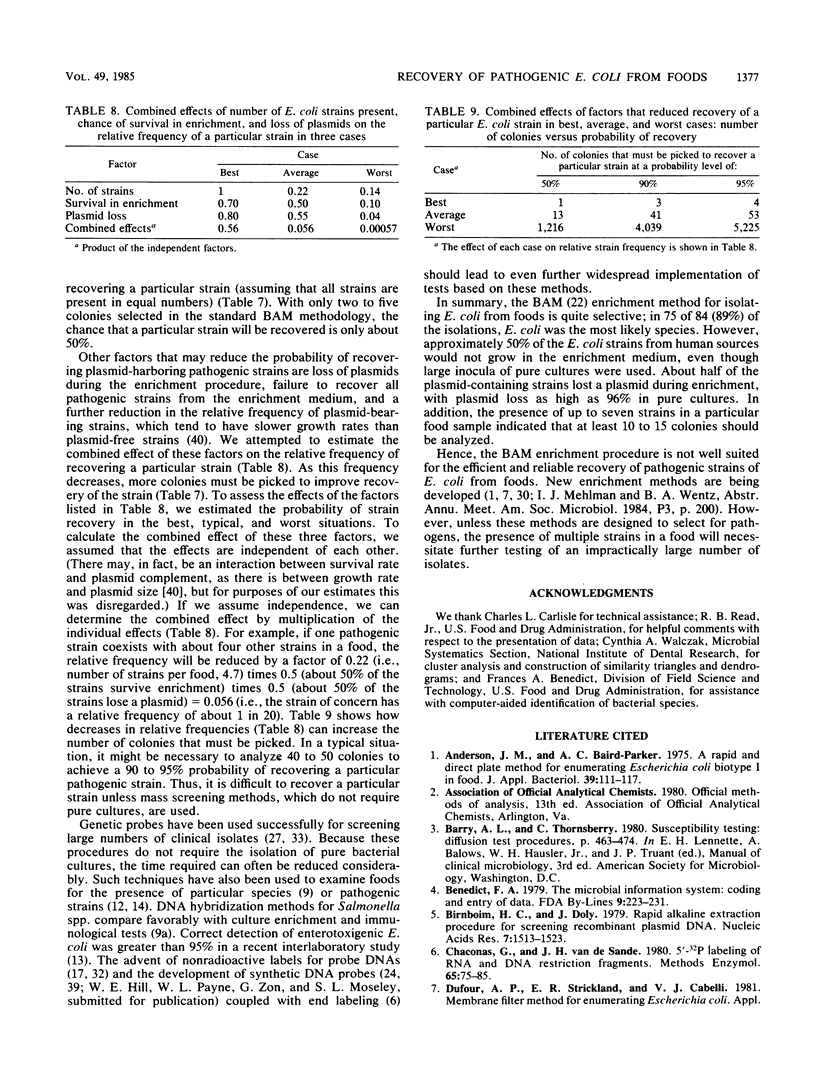
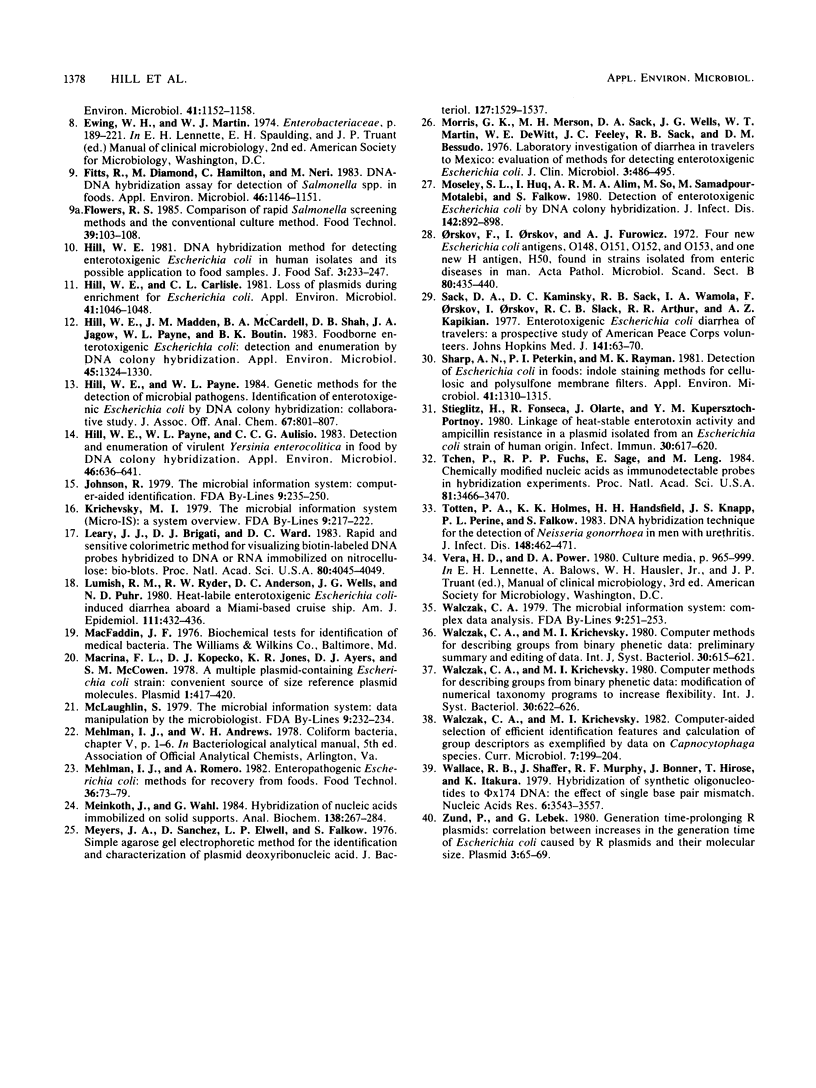
Selected References
These references are in PubMed. This may not be the complete list of references from this article.
- Anderson J. M., Baird-Parker A. C. A rapid and direct plate method for enumerating Escherichia coli biotype I in food. J Appl Bacteriol. 1975 Oct;39(2):111–117. doi: 10.1111/j.1365-2672.1975.tb00551.x. [DOI] [PubMed] [Google Scholar]
- Birnboim H. C., Doly J. A rapid alkaline extraction procedure for screening recombinant plasmid DNA. Nucleic Acids Res. 1979 Nov 24;7(6):1513–1523. doi: 10.1093/nar/7.6.1513. [DOI] [PMC free article] [PubMed] [Google Scholar]
- Chaconas G., van de Sande J. H. 5'-32P labeling of RNA and DNA restriction fragments. Methods Enzymol. 1980;65(1):75–85. doi: 10.1016/s0076-6879(80)65012-5. [DOI] [PubMed] [Google Scholar]
- Fitts R., Diamond M., Hamilton C., Neri M. DNA-DNA hybridization assay for detection of Salmonella spp. in foods. Appl Environ Microbiol. 1983 Nov;46(5):1146–1151. doi: 10.1128/aem.46.5.1146-1151.1983. [DOI] [PMC free article] [PubMed] [Google Scholar]
- Hill W. E., Carlisle C. L. Loss of plasmids during enrichment for Escherichia coli. Appl Environ Microbiol. 1981 Apr;41(4):1046–1048. doi: 10.1128/aem.41.4.1046-1048.1981. [DOI] [PMC free article] [PubMed] [Google Scholar]
- Hill W. E., Madden J. M., McCardell B. A., Shah D. B., Jagow J. A., Payne W. L., Boutin B. K. Foodborne enterotoxigenic Escherichia coli: detection and enumeration by DNA colony hybridization. Appl Environ Microbiol. 1983 Apr;45(4):1324–1330. doi: 10.1128/aem.45.4.1324-1330.1983. [DOI] [PMC free article] [PubMed] [Google Scholar]
- Hill W. E., Payne W. L., Aulisio C. C. Detection and enumeration of virulent Yersinia enterocolitica in food by DNA colony hybridization. Appl Environ Microbiol. 1983 Sep;46(3):636–641. doi: 10.1128/aem.46.3.636-641.1983. [DOI] [PMC free article] [PubMed] [Google Scholar]
- Hill W. E., Payne W. L., Crouch R. J., Davis V. M., English L. L., Ferreira J. L., Gemski P., Jagow J. A., Moseley S. L., Noah C. W. Genetic methods for the detection of microbial pathogens. Identification of enterotoxigenic Escherichia coli by DNA colony hybridization: collaborative study. J Assoc Off Anal Chem. 1984 Jul-Aug;67(4):801–807. [PubMed] [Google Scholar]
- Leary J. J., Brigati D. J., Ward D. C. Rapid and sensitive colorimetric method for visualizing biotin-labeled DNA probes hybridized to DNA or RNA immobilized on nitrocellulose: Bio-blots. Proc Natl Acad Sci U S A. 1983 Jul;80(13):4045–4049. doi: 10.1073/pnas.80.13.4045. [DOI] [PMC free article] [PubMed] [Google Scholar]
- Lumish R. M., Ryder R. W., Anderson D. C., Wells J. G., Puhr N. D. Heat-labile enterotoxigenic Escherichia coli induced diarrhea aboard a Miami-based cruise ship. Am J Epidemiol. 1980 Apr;111(4):432–436. doi: 10.1093/oxfordjournals.aje.a112918. [DOI] [PubMed] [Google Scholar]
- Macrina F. L., Kopecko D. J., Jones K. R., Ayers D. J., McCowen S. M. A multiple plasmid-containing Escherichia coli strain: convenient source of size reference plasmid molecules. Plasmid. 1978 Jun;1(3):417–420. doi: 10.1016/0147-619x(78)90056-2. [DOI] [PubMed] [Google Scholar]
- Meinkoth J., Wahl G. Hybridization of nucleic acids immobilized on solid supports. Anal Biochem. 1984 May 1;138(2):267–284. doi: 10.1016/0003-2697(84)90808-x. [DOI] [PubMed] [Google Scholar]
- Meyers J. A., Sanchez D., Elwell L. P., Falkow S. Simple agarose gel electrophoretic method for the identification and characterization of plasmid deoxyribonucleic acid. J Bacteriol. 1976 Sep;127(3):1529–1537. doi: 10.1128/jb.127.3.1529-1537.1976. [DOI] [PMC free article] [PubMed] [Google Scholar]
- Morris G. K., Merson M. H., Sack D. A., Wells J. G., Martin W. T., Dewitt W. E., Feeley J. C., Sack R. B., Bessudo D. M. Laboratory investigation of diarrhea in travelers to Mexico: evaluation of methods for detecting enterotoxigenic Echerichia coli. J Clin Microbiol. 1976 May;3(5):486–495. doi: 10.1128/jcm.3.5.486-495.1976. [DOI] [PMC free article] [PubMed] [Google Scholar]
- Moseley S. L., Huq I., Alim A. R., So M., Samadpour-Motalebi M., Falkow S. Detection of enterotoxigenic Escherichia coli by DNA colony hybridization. J Infect Dis. 1980 Dec;142(6):892–898. doi: 10.1093/infdis/142.6.892. [DOI] [PubMed] [Google Scholar]
- Orskov F., Orskov I., Furowicz A. J. Four new Escherichia coli O antigens, O148, O151, O152, O153, and one new H antigen, H50, found in strains isolated from enteric diseases in man with a discussion on the future numbering of K antigens. Acta Pathol Microbiol Scand B Microbiol Immunol. 1972;80(3):435–440. doi: 10.1111/j.1699-0463.1972.tb00057.x. [DOI] [PubMed] [Google Scholar]
- Sack D. A., Kaminsky D. C., Sack R. B., Wamola I. A., Orskov F., Orskov I., Slack R. C., Arthur R. R., Kapikian A. Z. Enterotoxigenic Escherichia coli diarrhea of travelers: a prospective study of American Peace Corps volunteers. Johns Hopkins Med J. 1977 Aug;141(2):63–70. [PubMed] [Google Scholar]
- Sharpe A. N., Peterkin P. I., Rayman M. K. Detection of Escherichia coli in foods: indole staining methods for cellulosic and polysulfone membrane filters. Appl Environ Microbiol. 1981 Jun;41(6):1310–1315. doi: 10.1128/aem.41.6.1310-1315.1981. [DOI] [PMC free article] [PubMed] [Google Scholar]
- Tchen P., Fuchs R. P., Sage E., Leng M. Chemically modified nucleic acids as immunodetectable probes in hybridization experiments. Proc Natl Acad Sci U S A. 1984 Jun;81(11):3466–3470. doi: 10.1073/pnas.81.11.3466. [DOI] [PMC free article] [PubMed] [Google Scholar]
- Totten P. A., Holmes K. K., Handsfield H. H., Knapp J. S., Perine P. L., Falkow S. DNA hybridization technique for the detection of Neisseria gonorrhoeae in men with urethritis. J Infect Dis. 1983 Sep;148(3):462–471. doi: 10.1093/infdis/148.3.462. [DOI] [PubMed] [Google Scholar]
- Wallace R. B., Shaffer J., Murphy R. F., Bonner J., Hirose T., Itakura K. Hybridization of synthetic oligodeoxyribonucleotides to phi chi 174 DNA: the effect of single base pair mismatch. Nucleic Acids Res. 1979 Aug 10;6(11):3543–3557. doi: 10.1093/nar/6.11.3543. [DOI] [PMC free article] [PubMed] [Google Scholar]
- Zünd P., Lebek G. Generation time-prolonging R plasmids: correlation between increases in the generation time of Escherichia coli caused by R plasmids and their molecular size. Plasmid. 1980 Jan;3(1):65–69. doi: 10.1016/s0147-619x(80)90034-7. [DOI] [PubMed] [Google Scholar]


